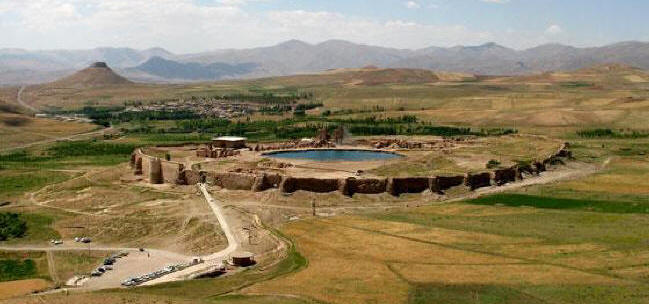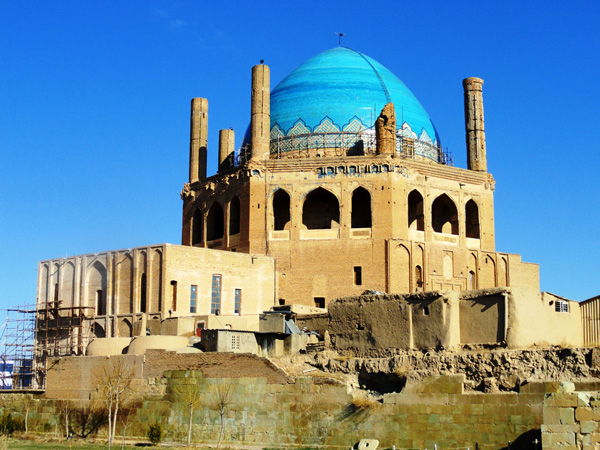History and Geography of Zanjan province
Zanjan province is located in central part of north-west of Iran. Zanjan, Abhar, and Khodabandeh compose the townships of this province.
Zanjan province is one of the historical regions of Iran. The antiquity of the province can be divided into
four historic periods:
Pre-historic ago (from 7th millennium BC.till early 3rd millennium BC.):
The most ancient and recognized historical vestiges belonging to pre-historic age goes to "Bardostin".
Culture which are known by small tools having about 30,000 years of antiquity .
Historic settlements in Eajrood region of Zanjan in 3rd and 2nd millennium BC: Indicates flourishing and sustainability of Iran’s civilization in this region.
Evaluation of black engravings on discovered earthenware of buff color shows the linkage and continuity of Damghan Hesar hill, Kashan Sialk hill, and Eajrood of Zanjan civilizations.
New historic age (late 2nd millennium BC. to early 7th century AD.):
The most distinct vestiges of this period is a kind of simple gray earthenware which conforms to simultaneity of Aryan tribes migration to this region. Teapot shape earthenware with relatively long hose was found in all tombs of this age which could be attributed to funeral ceremonies. There has not been a determinate government system in the region till early first millennium BC. Even Othartoui government could not expand its dominance over this region due to remoteness of it. According to Assyrians documents,this region was named Andya in 9th century BC. And its dwellers have probably communicated with Lulubi and Gouti tribes who resided in slopes of Zagross mountain range. There is ambiguity about the history of the region from 7th century BC. To late millennium BC. Whole Achaemenian period. The discovered coins "Derik" and "Riton" in Khodabendeh are the vestiges of Achaemenian period. The valleys of Zanjan Rood and Ghezel Ozan were more thriving in parthians and Sassanians times. Amongst the most important remains of this period Tashvir fire- temples can be pointed out.
Islamic period (from 7th to 19th century AC.): This period begins with conquest of Iran in the time of Osman caliphate. Existing texts and evidences show that this region was very thriving from economic, cultural and artistic points of view during the whole Islamic period. One of the reasons for selecting Sultanieh as capital by Mongol Ilkhanan was economic briskness of the region in 7th and 8th centuries AH. After the decline of Ilkhani government by Sarbedaran movement in 9th century AH. Zanjan was attacked by Taymour the lame and was damaged badly.
The region was relatively thriving from economic and cultural points of view in Safavid and Ghajar time specially during the reign of Shah Tahmasb and Agha Mohammad Khan.
Zanjan Township is 328 km. far from Tehran. Enjoying a mild weather in summer and cold weather in winter, Zanjan is composed of two great valleys of "Zanjan Rood" and "Sefid Rood" between which Gharavol and Angooran Mountains are located.
Takht-e Soleyman (Solomon’s Throne)
45 kilometers northeast of the city of Takab, a historic site can be seen. It is the heritage remained from the Sassanid era (226–650 AD). Takht-e Soleiman (Solomon’s Throne) is home to one of the three famous Sassanid fire temples. It is also where the kings of the Sassanid dynasty were crowned.
This monument was most probably built during the reign of King Pirooz (457- 484 AD), King Anoushirvan’s grandfather. Although archeological excavations in the historic site of Takht-e Soleiman have also revealed remains of the Achaemenid and Median eras, this ancient site is most known for its Sassanid monuments such as: Azargoshnasb Fire Temple, Anahita Temple, Hadaya (Gifts) Museum, Zendan (Jail) Mountain, and Belgheis Castle.

Remains of the only castle dating back to the Ilkhanid period (1256-1353 AD) can also be seen in this historic site. In addition to historic monuments, those who travel to Takht-e Soleiman may also see an absolutely eye-catching lake with changing colors in front of Khosrow’s portico. The deepest point of this lake is 112 meters from the sea level. Its temperature is reduced to 40 degree Celsius due to a natural spring that exists along its bed. The complex of Takht-e Soleiman and its landscape is the first Persian heritage inscribed in UNESCO’s List of World Heritage Sites after the Islamic revolution of 1979. It was added to the said list three years ago.
The Soltanieh Dome
Soltanieh Dome, which is located at Soltanieh town, is 35 kilometers from zanjan. This complex is famous monument and the greatest attraction of Zanjan province.T he Soltanieh district had been the home of various peoples before the invasion of Iran by the Mongols. The mausoleums of Hasan Kashi and the Dome of Soltanieh are among the prominent buildings. The most significant part of the stated complex is the Soltanieh dome. It is the biggest dome in Iran and one of the most splendid buildings throughout the Islamic worlds. The building of the monument was ordered by Soltan Mohammad Khodabandeh in 1283, and it took nine years to be completed. The dome with a diameter of 25.60 meters is 48.50 meters high. It is the third largest historical building in the world following Santa Maria Cathedral in Italy and Ayasofia mosque in Turkey. It is also the largest brick structured monument in Iran.
